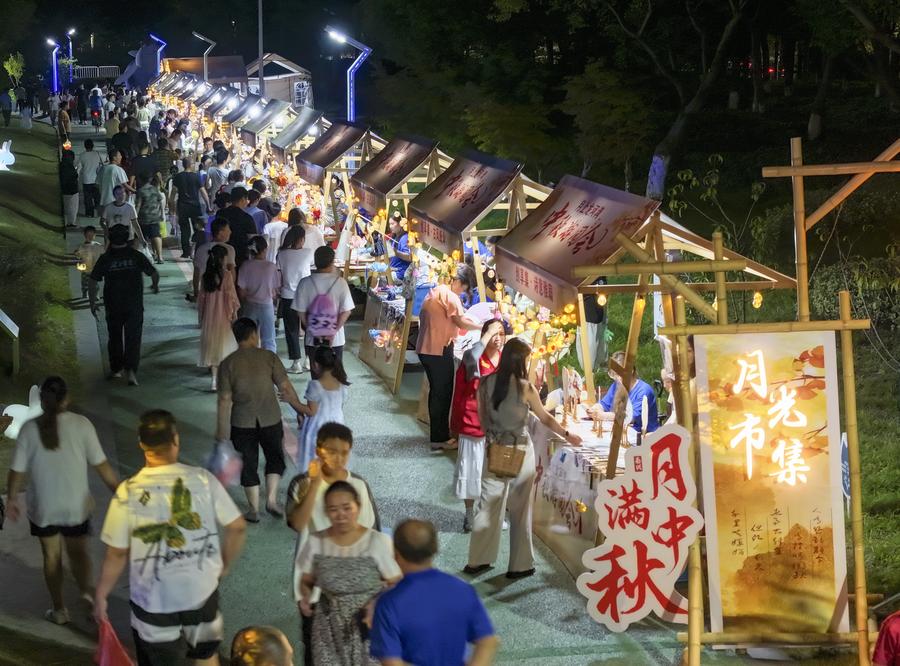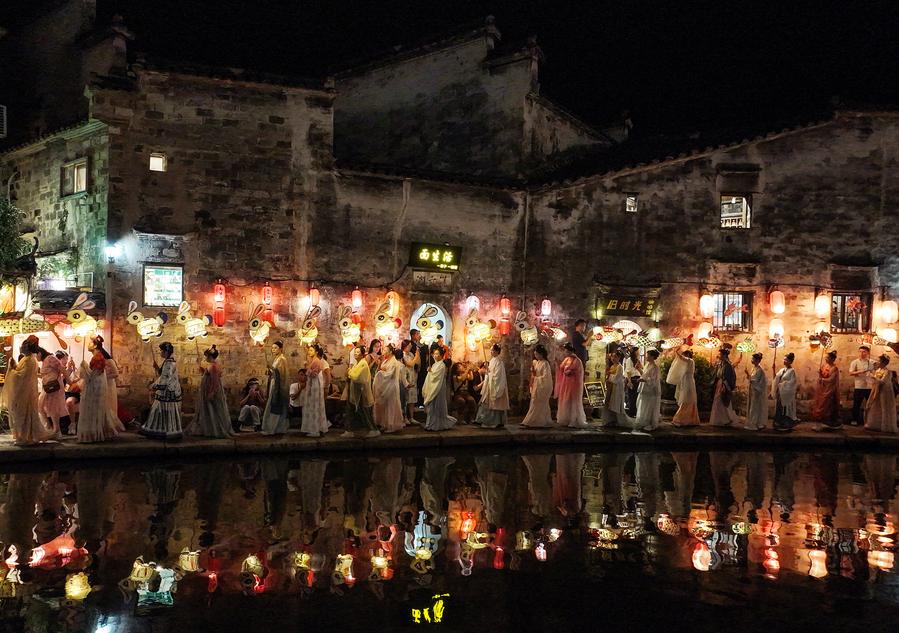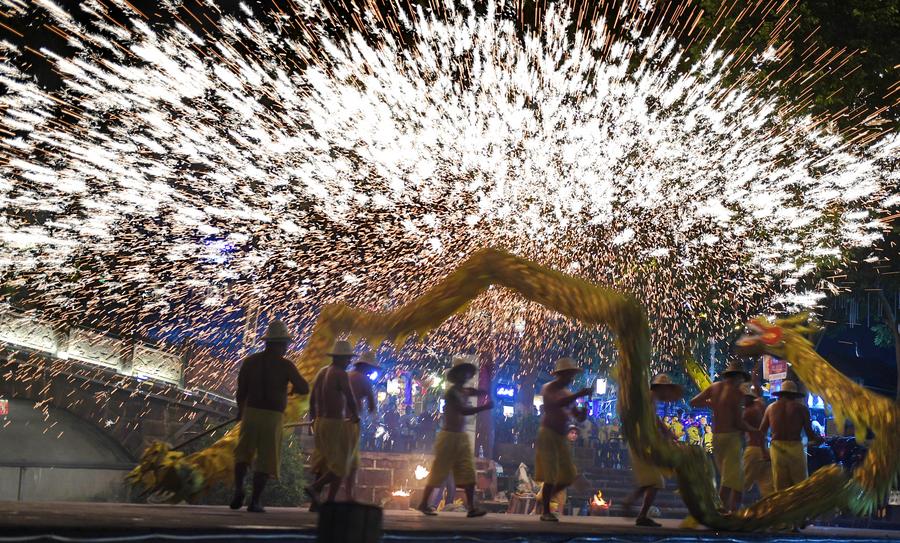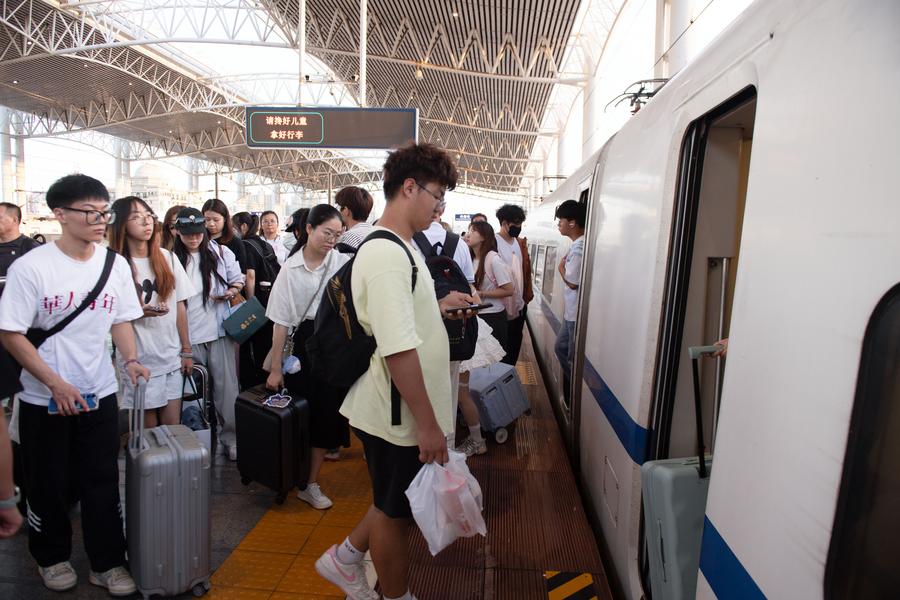Mid-Autumn "reunion economy" unleashes consumption potential

In this drone photo, tourists visit a night market at Taixing City, east China's Jiangsu Province, Sept. 15, 2024. [Photo by Gu Jihong/Xinhua]
TIANJIN -- During this year's Mid-Autumn Festival holiday, 31-year-old Li Runlin, an employee at a high-tech firm in north China's Tianjin Municipality, opted to travel back to his hometown of Tangshan in the neighboring Hebei Province to embrace the warmth of a family reunion.
His high-speed rail journey from Tianjin to Tangshan was swift, taking less than 40 minutes. The entire trip concluded in just over an hour, a testament to the convenience of modern transportation in China.
In preparation for his visit, Li meticulously selected some local delicacies from Tianjin, including the renowned Guifaxiang 18th Street Mahua, a traditional fried dough twist with a storied history, and steamed buns from the esteemed Go Believe brand. His total expenditure was over 500 yuan (about 70 U.S. dollars). In reciprocation, his family packed a selection of local flavors for him to take back.
For countless Chinese, the traditional Mid-Autumn Festival, which fell on Tuesday this year, symbolizes a time when families come together under one roof. Consequently, the "reunion economy" associated with this holiday has unleashed a surge in nationwide consumption.

In this drone photo, people dressed in traditional Chinese costumes attend a lantern parade in Hongcun Village of Yixian County, east China's Anhui Province, Sept. 15, 2024. [Photo by Shi Yalei/Xinhua]
During this period, short-distance travel emerged as a popular choice. Data from Qunar, a leading online travel agency in China, indicated a significant increase in family visits, highlighting the trend of returning to one's roots or opting for short, local excursions.
Qunar reported that the two-hour high-speed rail circles in regions such as Beijing-Tianjin-Hebei, Jiangsu-Zhejiang-Shanghai and Guangzhou-Shenzhen experienced heightened passenger activity.
Some individuals chose to explore their surroundings. According to Tuniu.com, a Chinese travel portal, local tours dominated the Mid-Autumn Festival travel market, accounting for nearly 50 percent of tourist visits. Traditional cultural experiences, such as folk art encounters, night tours of ancient towns, and museum visits, also rose to prominence as fresh trends.
Commercial zones and shopping centers have been hubs for family consumption during the festival. Over the holiday, the sales figures for department stores, supermarkets, specialty shops, catering services, and e-commerce platforms monitored by the Beijing municipal commerce bureau reached 4.67 billion yuan, marking a 4.4-percent increase year on year. The foot traffic in 60 key commercial areas in Beijing surged to more than 22.3 million person-times, a 21.1-percent rise compared to the previous year.

Folk artists perform a dragon fireworks dance at the Huanglong creek ancient town in Chengdu, capital of southwest China's Sichuan Province, Spet. 16, 2024. [Photo by Li Xiangyu/Xinhua]
In east China's Shanghai, savoring fresh meat mooncakes is a cherished tradition during the Mid-Autumn Festival. Time-honored food brands in the bustling Yu Garden, a commercial and tourist hotspot, have drawn crowds of domestic and international visitors. Staff at Shanghai Dexingguan, one of the time-honored local restaurants, revealed that their store sells 2,000 to 3,000 mooncakes daily, with the succulent fresh meat variety being the most sought-after.
The catering industry has also witnessed robust growth, with consumption potential continuing to be unlocked. In the past week, the search volume for festival-themed restaurants on the e-commerce platform Meituan soared by 433 percent compared to the previous month, while the order volume for festival-themed group purchase packages jumped by over 76 percent month-on-month.
"I had underestimated the enthusiasm for holiday dinners. During the Mid-Autumn Festival holiday, my family arrived at the restaurant at noon, only to find a lengthy queue. We had to wait for an hour and a half before we were seated," said Shi Chentao, a resident of Taiyuan, capital of north China's Shanxi Province.
"During this holiday, family dinners have seen a significant uptick. Our daily revenue has reached up to 60,000 yuan, nearly one-third higher than usual, with an average waiting time of about two hours," said Zhao Yu, manager of the OTF Pizza & Brunch at the Riverside66 shopping complex in Tianjin.

Passengers board a train at a railway station in Zhenjiang, east China's Jiangsu Province, Sept. 17, 2024. [Photo by Yang Suping/Xinhua]
The film market also experienced a surge in movie-going fervor during the holiday. According to data released by the China Film Administration on Wednesday, China's box office revenue for the three-day holiday reached 389 million yuan, with 9.57 million viewers.
The figure marks a slight increase from the 367 million yuan recorded in 2023 and the 371 million yuan in 2022, according to box office tracker Maoyan.
"I watched a feature film with my parents during the holiday. It's incredibly touching," said Ye Yutong, a resident of Hangzhou, capital of east China's Zhejiang Province.
A report by Changjiang Securities indicated that the themes and styles of the films currently on offer are diverse, encompassing a wide array of genres such as action, comedy, animation, and war, providing a multitude of choices for audiences. With the ongoing recovery of viewing demand, the country's film box office anticipates sustained growth after the Mid-Autumn Festival holiday.
























